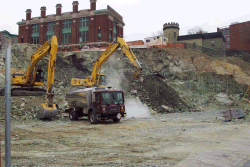
Since March 11, daily blasting has created a massive hole at Castle Point to make way for unapproved 800-car parking garage.
April 9, 2002 — For the past four weeks, a contractor for Stevens Institute of Technology has blasted and excavated the serpentine rock that comprises part of Castle Point at Hoboken’s waterfront. A recent test by a Stevens’ consultant confirmed that the dust surrounding the construction site contains asbestos that exceeds acceptable levels set by the federal Environmental Protection Agency. Stevens has made no public announcements regarding this hazard as Terminal Construction Company detonates explosives within the rock at 11 a.m. and 2 p.m. each weekday, sending clouds of dust high in the air. The blasting is expected to continue through the end of April.
The site of this blasting is adjacent to a number of youth athletic programs and a children’s play area. Across the street is Sinatra Park with its soccer field. Directly to the south is Hoboken’s only little league field and Stevens Park where parents bring their young children to play. No precautions have been taken thus far to water down the excavation site or, during the blasting, to prevent the dust from spreading throughout the neighborhood.
Chrysotile, also known as “white asbestos,” is one of several minerals that is found in serpentine rock. Chrysotile is the most common type of asbestos used in asbestos products, comprising over 90% of the asbestos found in buildings in the United States. Asbestos is a hazard when it becomes airborne and is inhaled in the lungs. The major health risks linked to asbestos are asbestosis, a scarring of the lungs; mesothelioma, a cancer of the lung and chest linings; and lung cancer.
On March 22, eleven days after the blasting began, a large section of serpentine rock on the north face of Castle Point, two blocks north of the excavation site, came crashing down. A car parked along the roadside was totaled. Representatives of Stevens Institute of Technology denied that this had anything to do with the blasting. For several days following this rock-slide, Sinatra Drive was closed and Terminal Construction scraped away other portions of the north face of Castle Point.
Serpentine rock is a rarely seen part of the earth’s crust. About 425 million years ago, a tectonic plate collided with a volcanic island system forcing up a band of this rock that stretches along the eastern region of this continent from Alabama up to Newfoundland. There are several rare outcroppings of this rock, including one at Castle Point in Hoboken and another in Staten Island. Stevens Institute of Technology, founded by the Steven’s family in 1870, has been built atop this natural bluff overlooking the Hudson River.
The extensive excavation now being undertaken by Stevens Institute of Technology is for an exposed, 800-car parking garage that will face Hoboken’s waterfront. No planning or zoning board approvals have been granted for this garage. Nevertheless, the Hoboken building inspector, Alfred Arezzo, issued a construction permit on November 20, 2001 that states, “install/construct foundation and parking garage.”
The parking garage is part of a master plan by Stevens Institute of Technology that includes expanding their campus to three waterfront parcels. Two of these parcels are not owned by the school: the Union Dry Dock site, owned by a ship repair company and the other, the 14-acre Maxwell House property privately owned by investors with a development application currently before the Hoboken Planning Board.
Ron Hine, the Executive Director of the Fund for a Better Waterfront, exclaimed, “this massive parking garage will blight Hoboken’s waterfront. Exposed parking garages should be a thing of the past in Hoboken.” Hine pointed out that at the south and north waterfront parking garages are appropriately shielded behind building facades containing stores, restaurants and apartments. “This Stevens’ garage represents bad planning and bad design. The City should not allow this to happen,” Hine said.
